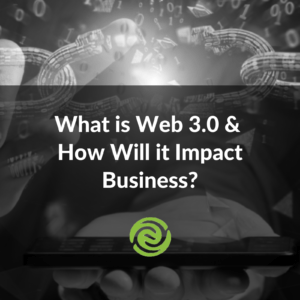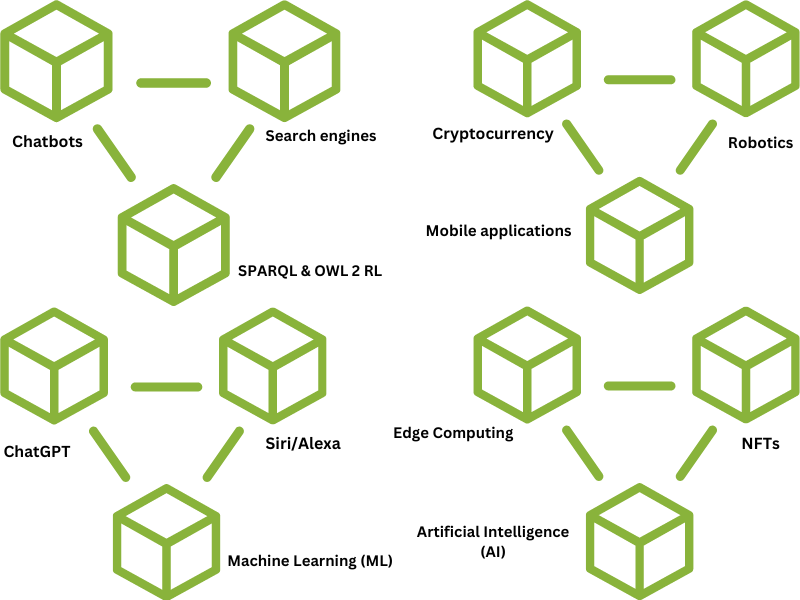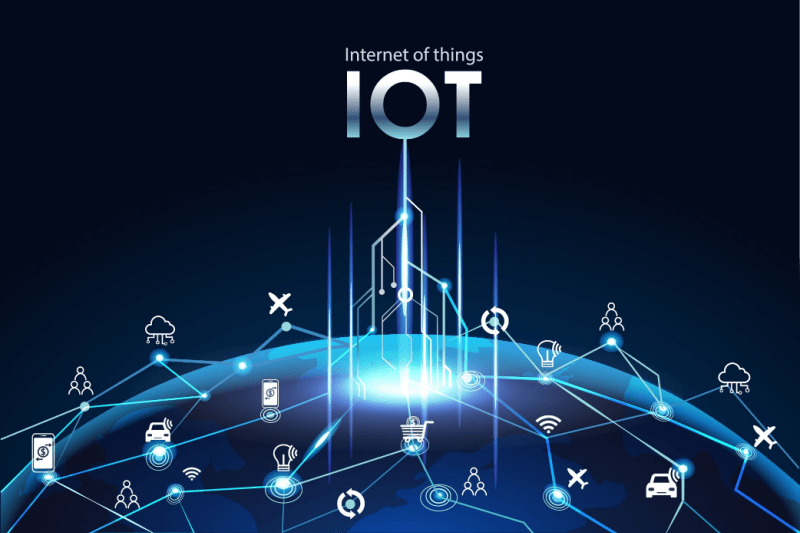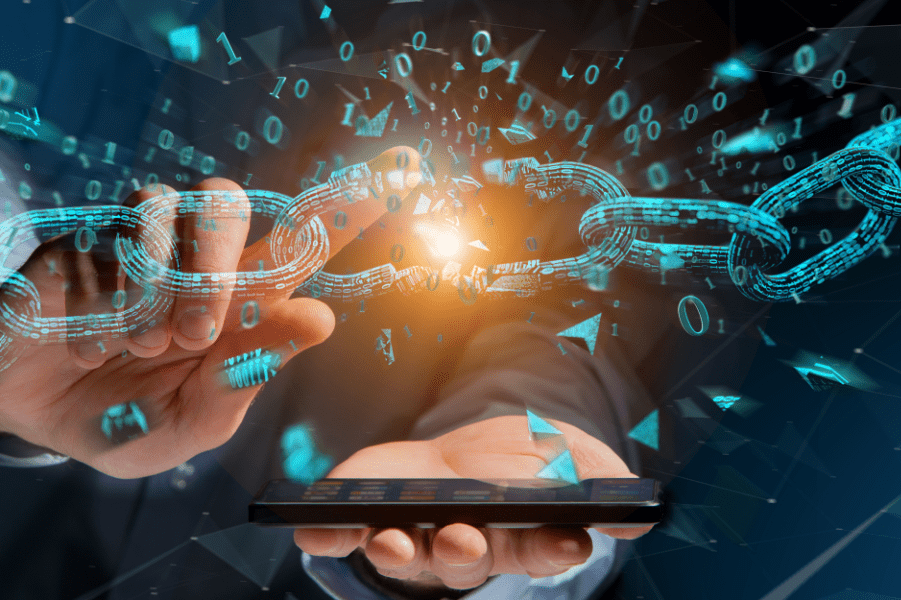What is Web 3.0 & How Will it Impact Business?
 Web 3.0, also known as Web3, is no longer the “future” of the World Wide Web. It is here and being implemented rapidly. The basics of Web 3.0 include the Semantic Web, self-controlled content, heightened transparency and security, and intelligent human-computer interaction.
Web 3.0, also known as Web3, is no longer the “future” of the World Wide Web. It is here and being implemented rapidly. The basics of Web 3.0 include the Semantic Web, self-controlled content, heightened transparency and security, and intelligent human-computer interaction.
So, what exactly is Web 3.0 and how will it impact your business? Find out here as we share the basics of Web 3.0 and its business opportunities.
What is Web 3.0?
If you do a search for “What is Web 3.0?” you will find an array of language that sounds a bit frightening. You’ll see terms like Semantic Web, Trustless, Zero Trust, Self-Sufficient Understanding, and Decentralized Information, but there is no need to fear. You’re probably already using Web 3.0 with these features and feeling good about it.
The best way to understand Web 3.0 and the corresponding terminology is to learn how we got from the original World Wide Web (www) to Web 1.0, Web 2.0, and now, Web 3.0.
Web 1.0
When the World Wide Web began, users had to type in an IP address to search for information, which resulted in receiving static information. There was no “interaction” just data. This was the earliest version of the Web until it began iterating into new, more intuitive versions, starting with Web 1.0.
Web 1.0 began around 1991 and saw us through 2004, overlapping in time as it evolved into Web 2.0. Web 1.0 was revolutionary as a worldwide content delivery network (CDN). It was mostly for personal and academic use; not many companies were using Web 1.0 early on. Some of you might even remember Gopher.
Some Web 1.0 characteristics included:
- Content was provided from the server’s file system.
- Static-hosted web pages used HTML to share content.
- Information was on read-only pages that were not interactive.
- Advertisements were not allowed.
Web 1.0 Examples
- LiveJournal — founded in 1999 by American programmer Brad Fitzpatrick as a way to keep his high school friends updated on his activities.
- Myspace — founded in 2003, it was the first social media platform to go global and the largest social site in the world from 2005–2009.
Web 1.0 Evolves into Web 2.0
Web 2.0 was coined around 2004, keeping the best of Web 1.0 and quickly pushing capabilities to new heights. Web 2.0 is what we know the web to be today. It allows us to generate content and interact with websites, web pages, web applications, mobile apps, social media, and other types of automation, as well as with each other, rather than just viewing information and data. In business, it allows us to do more with less, reduces risk, and improves company culture.
The main characteristics of Web 2.0 include:
- Implementation of JavaScript and AJAX to make sites more interactive.
- Development of Cascading Style Sheets (CSS) to make styling sites easier.
- Creation and distribution of user-generated content.
- Enhancement of communication channels for better interaction, especially social media.
- Higher-level development for programming power to be collected in data centers.
- Simultaneous sorting, sending, and receiving of huge amounts of data.
- Cloud computing and infrastructure solutions.
- Development of Application Programming Interfaces (APIs) to create communication between software applications.
Web 2.0 Examples
The Internet of Things (IoT) interconnects our world by collecting and sharing data between devices to use them in a more efficient manner.
Social media sites such as Facebook, Twitter, Instagram, Pinterest, LinkedIn, etc., all allow user and community input and interaction on the web and via mobile apps.
All web applications, such as e-commerce, portals, business automation, communication systems, etc., make it easier to conduct business and perform tasks.
All mobile applications on smart devices, such as store apps, social media apps, banking apps, delivery apps, etc., create a world where we never have to leave home to survive.
An Application Programming Interface (API) creates essential back-and-forth communication between your smart devices and mobile apps and web apps.
Robotics Process Automation takes physical, manual tasks and automates them to eliminate repetitive actions and create efficiency.
The start of Artificial Intelligence (AI), which works behind the scenes to provide immediate answers to our queries and has come into our everyday lives via chatbots, virtual assistants, voice-activated smart devices and appliances, and facial recognition.
Machine Learning (ML) (dates back to 1943) now allows software applications, without being pre-programmed, to predict accurate outcomes for things like internet searches, spam filters, personalized website recommendations, detecting unusual banking transactions, and voice recognition.
With Web 3.0, we will have full control over our content and intellectual property, and the ability to sell our own data through decentralized data networks.
Enter Web 3.0
As mentioned, we have already crossed over into the Web 3.0 era of technology in the last few years, but with the release of natural language processing (NLP) tools driven by AI technology, such as Siri, ChatGPT, and Jasper, we can see the evolution more clearly.
Semantic Web
The technologies we were dipping our toes into during Web 2.0 have become sophisticated enough for us to move forward with confidence. Web 3.0 is still evolving as the Semantic Web (Self-Sufficient Understanding), enabling people to search, produce, and share material and information much more easily using word understanding and concepts instead of numbers and keywords, providing faster, more relevant outcomes.
Decentralized Data Networks
This version of the world wide web benefits users who make content instead of the platform where the content is published. This is a huge advantage! You will have full control over your content and intellectual property and have the ability to sell your data through Decentralized Data Networks. This freedom also allows for a better UI/UX.
According to SimpliLearn, “In Web 2.0, computers search for data that is kept at a fixed location, typically on a single server, using HTTP in the form of distinct web addresses. With Web 3.0, information might be stored simultaneously in numerous locations and become decentralized, since it would be found based on its content rather than a single location. This gives individuals more power by dismantling the enormous databases that internet goliaths like Meta and Google presently maintain.”
Trustless dApps
Additionally, Web 3.0 apps, known as dApps, will be Trustless (Zero Trust) and Permissionless. You will be able to interact directly with others who buy and sell goods and services without using a trusted intermediary or obtaining permission.
Blockchain
A large part of Web 3.0 is based on Blockchain technology, which is most widely known due to cryptocurrency but is also being used in other areas, such as healthcare and banking. It offers transparency and complete accuracy in unalterable and indestructible data that’s sharable without fear of manipulation. The most popular example of this is cryptocurrency reducing the need for banks. All financial transactions can be facilitated between two parties without a bank in the middle. With Web 3.0 and dApps, the middleman goes away, and you have complete control over your information.
Semantic Web uses enriched query language and comprehension and links data via a “web” to enable us to produce, share, reference, and connect material through language-based search and analysis.
Exciting Web 3.0 features …
- The Semantic Web uses language-based search capabilities.
- Programming power is pushed out of the data center and into the hands of users.
- Decentralization of information makes it widely available to everyone.
- Data will be produced by various powerful computing resources, i.e., desktop computers, mobile phones, appliances, automobiles, and sensors.
- Built on top of blockchain which is irrefutable, unbreakable technology or “trustless.”
- Permissionless — you own your data and don’t need permission from an intermediary, such as Google or Bing, to search, publish, or share information.
- Transactions will be tracked on a distributed ledger.
- Smart contracts will eliminate the need for people to rely on a centralized organization (like a bank) to maintain data or data integrity.
- Blockchain will make it possible and/or required for people to produce digital goods and Non-Fungible Tokens (NFTs) to protect intellectual property

As explained by geeksforgeeks.org, “The Semantic Web (3.0) promises to establish “the world’s information” in a more reasonable way than Google can ever attain with its existing engine schema. This is particularly true from the perspective of machine conception as opposed to human understanding.”
The Benefits of Adopting Web 3.0 into Your Business
The benefits of adopting Web 3.0 into your business are endless. The ease of using, creating, sharing, and protecting information and data becomes elementary. The sheer level of transparency, data accuracy, and unalterable and indestructible information removes the fear of data manipulation and security issues and provides accurate traceability. Web 3.0 will create an even better customer experience and employee experience while reducing business risk.
Web 3.0: The Impact on Business
- Creates a better customer and employee experience.
- Reduces business risk with greater efficiencies and processes.
- Better data security/data encryption for less vulnerability.
- Content is accessible to everyone, ending data monopolies.
- Users will have full control over their data.
- Users will be able to choose what information to share and what not to.
- Creator economy – creators get actual value for their work.
- Ease of access/accessibility to any kind of data – disseminates data and connections between services.
- Easy, unalterable tracking of history and information.
- Greater transparency in every process and action.
- Increases speed of transaction processing and verification.
- Contributes to cost efficiency across the organization.
- Simplifies problem-solving and complex, heavy-knowledge tasks.
The Bottom Line … Web 3.0 Creates Business Opportunities
Web 3.0 might sound overwhelmingly different from Web 2.0, but we have already become familiar with many facets of Web3. The pandemic catapulted us into using AI and blockchain technology with more intuitive apps, virtual assistants, smart products, chatbots, and more.
Using Web 3.0 in your business will offer freedom of information and direct control over your own data and IP, without an intermediary, creating business opportunities. You will realize improved personal and business efficiencies, better customer and employee experiences, tighter, more accurate processes, heightened security, and enhanced collaboration, all contributing to greater profitability.
Ready to Learn More About Web3? Contact Swip Systems for a No-Obligation Conversation
The big question is … how do you implement Web 3.0 into your business? By partnering with a software development company, such as Swip Systems, that specializes in customizing the latest technologies to your business needs.
We are here to help you and your company’s team wade through Web3’s technology changes and adopt them with less stress and better outcomes. We have over 250 years of combined development and leading-edge technology experience and love to help businesses and entrepreneurs reduce business risk and stay competitive. Contact us today for a no-obligation conversation about how Web 3.0 can help improve your company’s profitability. 877.377.SWIP






